- Home
- Tony Hillerman
Seldom Disappointed: A Memoir Page 2
Seldom Disappointed: A Memoir Read online
Page 2
Years later my infantry company liberated a villa in Alsace that looked enough like the old monastery to provoke an awful flood of nostalgic homesickness. The owner had fled, leaving on his walls pictures of horses and autographed photographs of himself with Heinrich Himmler and other important Nazis. One of my companions opened the wall safe with a grenade and we left with pockets full of worthless Vichy French francs and a bundle of good cashable deutsche marks. We were caught and made no profit from the burglary but even that affair proved lucky. Being arrested caused us to be hauled back to the villa, where we had to count out the money under the eyes of a clean, well-fed, well-paid major wearing a West Point ring. That caused us to miss a nasty little fight to clear Grube, a Lower Vosge village held by an SS armored unit. (Better to be embarrassed than shot at.)
But back to Sacred Heart. Adjoining the monastery grounds and at the very edge of the area that I include in our village, stood St. Mary’s Academy. The Sisters of Mercy decided that Potawatomi Indian girls had as much right to an education as boys the Benedictines enrolled. They built a great wood frame building, two stories with basement and lined all around with porches. While the boarding students were mostly Indian girls, the sisters also admitted day students, including boys.
Oklahoma in those days required an eighth-grade education. Sacred Heart offered either St. Mary’s or Georgetown School.
Why was the public grade school at Sacred Heart, a village in which no one could remember a George ever living, named Georgetown? My guess is that since Sacred Heart was a very Roman Catholic, Popish, Mackerel Snapper–sounding name and the board of education was 100 percent Protestant, the board considered Georgetown a better choice. But why did my brother and I, white males, go to a boarding school for Indian girls? Mostly, I guess, because of the religious instruction it offered. Partly because even though Georgetown School had two rooms it hired only one teacher, a young man who instructed grades one through four in one room and handled five through eight in the other. That arrangement wouldn’t have bothered Papa, who had been the only teacher in just such a school in Texas. What might have bothered him was the notion that the teacher was a right-wing Ku Klux Klan Republican. The books in Papa’s little bookcase dealt with law and political philosophy and the ones I remember best were the complete works of a rabid left-wing writer who published The Iconoclast, a firebrand pro-workingman, pro-union, anticapitalist newspaper. Had Papa been born in Munich instead of Missouri, he’d never have survived the Nazis.
I have not mentioned any youth recreational facilities in the foregoing. A swing set sat under the only tree at Georgetown School but it was rarely used because it was downwind from the two outhouses. St. Mary’s Academy had a swing set, merry-go-round, and slide in its playground, but boys were kept on the other side of the fence. (The sisters forgave us for not being Potawatomies, but not for being male.) There were usually only about nine or ten boys enrolled, not enough for regular baseball or football (basketball had not yet found its way to rural Oklahoma), so we played One-Eyed Cat, dodge ball, and similar stuff in the pig pasture behind the barn.
Our favorite pastime was Ape, which involved scratching two lines in the dirt about fifty feet apart and then drawing lots to determine who would be Ape. Ape would post himself between the lines, and we would run from line A to line B with Ape trying to catch us. When the Ape caught one he became another Ape, helping in the catching process, until finally the single runner left was the winner. Usually this was my cousin Robert, a contemporary of my brother Barney. He was fleet, agile, taciturn, and strong; he did everything well and was my boyhood hero.
Then along came the Eisheid Brothers, Jimmy and Billy, and the game changed. The Eisheids were visitors from another planet, city boys. Every rural kid knew city boys were sissies, but the Eisheids hadn’t got the word. Instead of submitting when caught as we played Ape, the Eisheids would struggle. This idea seemed manly. It spread. Soon making a capture involved pinning the runner to the ground. Thus we’d return to the classroom after recess marked with grass stains and gravel scratches. Then the Eisheids took it another step. They had to admit they were captured. Jimmy usually would submit after a couple of fingers were bent backward to their limits, but not Billy. He had to be choked. The technique was to cut off his air supply, ask him if he was caught, release the pressure long enough to register his “No,” and then choke him again. This continued until Billy said yes. The first time Billy passed out, producing the panicky screaming that brought one of the sisters rushing out to investigate, we persuaded her that Billy had merely fainted. The second time it happened she was skeptical. The third time she pretended she would take Billy to Konawa to see Dr. Giesen (the only medico in our end of the county). That forced the truth out of Billy. And that put an end to Ape.
The kids at Georgetown School had only one game. It was baseball. It went on year-long and it provided material for the only thing I ever published about my hometown—the introduction to a scholarly book about one- and two-room schools in the Great Plains States. The Georgetown team entered the Oklahoma American Legion grade-school baseball tournament. They won their way to the finals and went up to Oklahoma City to do battle with a huge urban grade school in Capitol Hill.
If I expect you to believe this could happen I must explain that rural education in the 1930s was much different (at least in Pottawatomie County) than it is today. The law requiring completion of the eighth grade didn’t say when. Farm kids missed a lot of days in spring plowing and planting time, and even more during the wheat harvest and cotton-picking months. The larger boys would also skip when roughneck or roustabout jobs were available at well-drilling sites in the oil patch. Therefore, while city grade schools were fielding teams of thirteen- and fourteen-year-old eighth graders, the age level at Georgetown with just a few kids to pick from, ranged from ten-year-old third graders up to Nag Nonie, who was completing his eighth grade at twenty-one. Three of my cousins were on the team. Nibs, who was about nineteen, Goober, who was seventeen, and thirteen-year-old Larry—all sons of Uncle Chris Grove, who loved literature but loved baseball even more. Georgetown took ten players to the big city. One got drunk the night before the big game and was sent home. (Oklahoma retained alcohol prohibition until after World War II, which made it easy for kids to get whiskey just as the current “war on drugs” now makes it easy for them to get whatever we are prohibiting.) That left nine. The Capitol Hill coach objected to the 210-pound twenty-one-year-old third baseman, arguing that if there wasn’t an age limit for grade-school baseball there damn sure should be. Nag was declared ineligible. That left an eight-man nine, but Georgetown was winning anyway because the Capitol Hill kids couldn’t hit our nineteen-year-old pitcher’s fast ball. Alas, it was then decided the rules required a full team and Georgetown had to forfeit the game.
After grade eight, we boys had to catch the school bus to Konawa High for the second lap on our road to enlightenment. That came at about the time our family was leaving Sacred Heart, moving a mile and a half down the section line to a little farm my mother owned. But there’s a bit more to be told about life in the village pertinent to the point of this memoir. It concerns the development of Barney and me as War Lovers.
2
Preparing for War
Perhaps obsession with war games is normal for young males. Or perhaps in the 1930s it was the product of the international saber-rattling, which was dominating newspapers, magazines, and radio. Mussolini was trying to re-create the Roman Empire by conquering Ethiopia, the Japanese were doing their invasion of Manchuria, and the German General Staff was testing its new tanks and fighters against Stalin’s equipment in the Spanish Civil War. The newscasts delivered by our radio (when the battery was charged) were alive with accounts of bombing raids and battles. So was the Sunday Kansas City Star, to which Papa subscribed, and the back issues of Life, which our family dentist saved for us. Life editors were as fond of war as were we boys.
Our war games included one with marbles
. Each player placed his army on the battlefield, took turns getting one shot with each marble at the enemy marbles. Marbles hit were dead. The last kid with marbles left won. It didn’t stay simple. Soon we were digging networks of marble-depth trenches, molding marble-sized tanks of clay with matchstick cannon barrels, etc. Barney wrote our version of the Geneva Convention war rules. Each marble could be moved three inches after each turn, each tank could be moved a foot, etc. We played increasing complicated versions of this well into our high school years.
As grade schoolers, we were also playing Cavalry and Comanches, riding imaginary horses through the woods, creeks, and cow pastures, carrying wooden sabers, horseweed stalks as lances, and using clay balls (carried in old socks hung from the side buttons of our overalls) as ammunition. The rules required one hit by a missile to fall and cheating was rare. Sacred Heart offered a limited recruiting pool for our wars, and the genuine farm boys away from the village were kept busy chopping cotton, plowing, and so forth. Usually we had only Barney and me, Cousin Cecil from down the section line, the three Delonie boys, and, when circumstances brought them in from the city, the Eisheids. Sometimes Cecil’s big brother Robert would join us, but Robert matured earlier than we did and usually was involved with more serious affairs.
The Delonie boys, being Indians, were assigned Comanche roles. But every Saturday evening the Rex Theater in Konawa would be opened and a movie would be shown. These movies in the 1930s tended to be westerns and the Delonie boys saw one of these. This made them aware that in Cavalry vs. Indian battles the Indians lose. Henceforth, even though as Potawatomis they had no aversion to shooting Comanches, we Hillerman boys had to alternate in the roles.
For our trench warfare, fought in the mountainous slag heap of cotton hulls left beside the gin, we chose up sides. Now cotton hulls are ground, bagged, and sold as mulch. Then they were dumped, year after year, forming towering piles. Dig away the newly dumped and you reached levels where pressure and decay had compressed them into layers about the texture of sponge cake. In these great hills of rotted hulls we created networks of trenches and tunnels in which to reenact the awful slaughter of World War I.
Nature had improved this ideal site with a row of bois d’ arc (Osage orange) bushes rimming the dump. The “oranges” they produced resembled grapefruit in shape and color but were harder and heavier—ideal cannonballs. Hits with hard-thrown clay balls and rubber-gun bands stung a little and they remained our small arms. But before we discovered the Osage orange cannonball the only elements of danger adding spice to the game were the occasional cave-ins of trenches or collapse of tunnels, which left one buried and scared for a bit. Being hit with an Osage orange really hurt, producing bruises, cut lips, loose teeth, bloody noses, and so forth. That added nervous tension to the game. It also finally ended it.
One of the Delonie boys (Tommy, probably too little to be playing this anyway) stuck his head out of a trench to snap off a rubber-gun shot just in time to be hit right between the eyes by an Osage orange. We revived him with water from the gin pond, but Tommy ran home screaming. A moment later his dad came roaring out the back door of his house, also screaming. We abandoned our trenches and fled, never to resume the game.
We didn’t abandon the cotton yard, however, nor other war games. On summer evenings we rolled tires. The little skinny tires off Model A or B Fords were fighter planes. Truck tires were bombers. The idea was to maneuver your tire into position to sideswipe an enemy tire and send it wobbling into a crash.
The inner tubes that came out of these worn-out tires were cut into bands—ammunition for rubber guns. Barney had made an arsenal of eleven of these for us. Eight were single-shot pistols, fired by squeezing the clothespin on the handle. Three were automatic rifles, an invention of his. They were loaded by stretching the bands from the end of the barrel and pressing them over a string into a sequence of notches. These were fired, single shot or in a murderous burst, by pulling the string. The pain when shot at close range was such that we finally had to ban them from our indoor version of the game.
When winter and early darkness made the cotton yard inhospitable we moved our war into the kitchen. To explain that I must pause and explain our home. That requires explaining “Shotgun Houses.” They were American ingenuity’s answer to the need of oil field workers, who would spend a few months drilling a well then move to wherever they could find a job drilling another one. The house that met their needs had a light wood frame and was narrow enough to be hauled on a flatbed truck. On our lot east of the cotton yard Papa had arranged two of these in a T-shape. The house fronting the street was a heavier three-room version. The room on the east end doubled as the parlor, den, and parental bedroom. There Mama and Papa entertained guests and there the radio was kept. When working it brought us “Little Orphan Annie,” “Jack Armstrong,” “Amos and Andy,” Frank Buck capturing his wild rhinos, the news and reconstituted rebroadcasts of St. Louis Cardinal games. And it was there the five Hillermans knelt each evening to thank the Lord for another day completed. I can still remember the feel of the linoleum under my knees, and the print of a Cruxifixion scene with Christ looking down at us from the cross. The prayers Papa led were mostly thanks for blessing our family with such happiness, but we never forgot to include an appeal for rain.
The room in the center became the entrance foyer, storage area, and hallway. The west-end room was the kitchen, dining room, and laundry. Here we took our baths in a round galvanized tub filled with water pulled from the backyard well and heated in buckets on the cookstove.
The exit door of this west room opened into the backyard. There stood the rain barrel, which caught runoff from the roof to augment bath and laundry water, the woodpile which fueled the cookstove, the well from which hung the pulley and well rope by which we hoisted drinking and cooking water to the surface, and the root cellar. The cellar was equipped with rows of shelves holding the year’s supply of Irish potatoes, sweet potatoes, onions, etc., and row upon row of Mason jars containing beets, peas, green beans, corn, pickles, peaches, pears, applesauce, blackberries, and assorted jams and jellies—mostly grown in Mama’s garden or on our trees, and all peeled, prepared, cooked, and preserved in the torrid heat of the Oklahoma summer prior to the invention of air conditioning.
Behind this root cellar was the “chicken fence,” which separated our yard from the territory occupied by the chicken house, the chickens, the barn, and Bossy, our milk cow. The family outhouse stood demurely out of sight beyond the chicken house.
The rest of home was formed by a smaller two-room shotgun house tacked on to the front one to form a stem of the T. This provided the bedroom shared by Margaret Mary, Barney, and me and a storeroom at the end, occupied by boxes of apples, clothing waiting for the season to change, and so forth.
More important to me, the storeroom held a huge (by boyhood standards) and sinister black trunk. The parental cover story was that it held family keepsakes, heirlooms, photo albums, documents, and other such valuable and irreplaceable stuff and it was therefore off-limits for kids. But in the awful reality that comes to boys in their dreams I understood it was actually the den of a gorilla. On windy nights I would hear him scratching and the lid creaking as he tried to push it open. Barney finally tired of being awakened with my elbow in his ribs and my whispered demands for an explanation of the noises. He got me out of bed, took me back there, opened the trunk, and showed me it was so crowded with photo albums, old correspondence, documents, what must have been a wedding dress, and so forth, that no gorilla was plausible.
That helped, but the gorilla reappeared years later when I was doing my sleeping in the Army’s Third General Hospital at Aix-en-Provence. My most popular nightmare there had me trudging through a rainy woods, carrying my mortar, hearing the whistle of artillery rounds and the sharp sound of tree bursts, passing Sergeant Arras, who was lying face up in the ditch looking at me and saying something I couldn’t understand. But the gorilla also showed up often, and now I would h
ear the storeroom door creaking open and I’d know that if the light were a little better I’d see him looking out at me.
Aside from the sinister storeroom, I have nothing but good memories of that house. Papa had built a porch across the front of it and screened in part of that for sleeping on those nights when the heat was intolerable. The entire structure was mounted on pedestals of concrete blocks, which made it relatively level. The roof never leaked, and air circulated through it in such a way that on torrid summer days the wet towels Mama hung on the screens provided a nice touch of evaporative cooling. Even the odd way the floors warped in our kids’ room wasn’t all bad. The boards bowed up in the middle, which meant lost marbles could always be quickly found in the corners.
The downside of the warping was caused by dogs sleeping in the dust under the house. Country dogs collect fleas, even our own beloved German shepherds, Lad and Wags. Fleas have survived down through untold eons by developing fantastic jumping skill plus a radar system for detecting warm-blooded food supplies passing by. Thus we three warm-blooded Hillerman kids learned not to linger over the cracks between the warped boards of our bedroom floor during the summer. When hot weather made fleas active we countered with a run-and-jump method of getting to bed.

 People of Darkness
People of Darkness Talking God jlajc-9
Talking God jlajc-9 Skinwalkers jlajc-7
Skinwalkers jlajc-7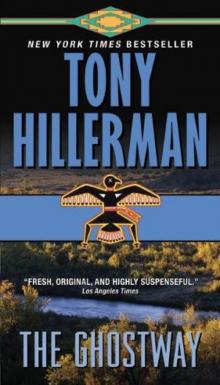 The Ghostway jlajc-6
The Ghostway jlajc-6 The Dark Wind jlajc-5
The Dark Wind jlajc-5 The Blessing Way
The Blessing Way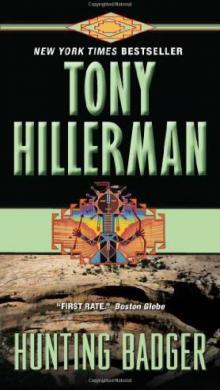 Hunting Badger jlajc-14
Hunting Badger jlajc-14 Seldom Disappointed: A Memoir
Seldom Disappointed: A Memoir Coyote Waits jlajc-10
Coyote Waits jlajc-10 Skeleton Man jlajc-17
Skeleton Man jlajc-17 The Shape Shifter
The Shape Shifter Sacred Clowns jlajc-11
Sacred Clowns jlajc-11 The Fallen Man jlajc-12
The Fallen Man jlajc-12 The First Eagle jlajc-13
The First Eagle jlajc-13 Listening Woman jlajc-3
Listening Woman jlajc-3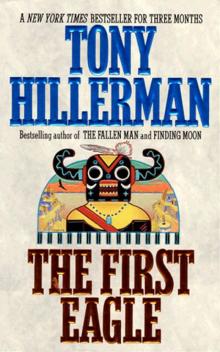 The First Eagle
The First Eagle Skeleton Man
Skeleton Man The Sinister Pig jlajc-16
The Sinister Pig jlajc-16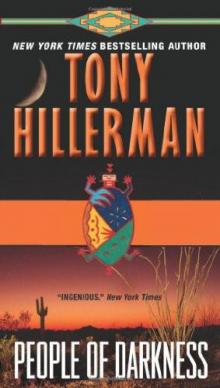 People of Darkness jlajc-4
People of Darkness jlajc-4 The Blessing Way jlajc-1
The Blessing Way jlajc-1 A Thief of Time
A Thief of Time The Wailing Wind
The Wailing Wind A Thief of Time jlajc-8
A Thief of Time jlajc-8 The Wailing Wind jlajc-15
The Wailing Wind jlajc-15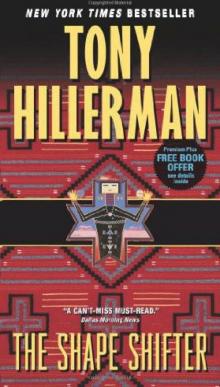 The Shape Shifter jlajc-18
The Shape Shifter jlajc-18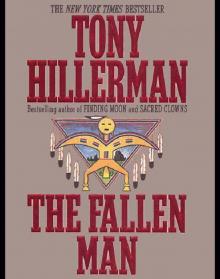 The Fallen Man
The Fallen Man Finding Moon
Finding Moon